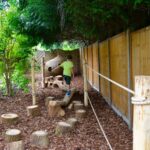Gardens are a wonderful way to introduce children to the wonders of nature and foster their creativity and sense of responsibility. Designing a garden specifically with kids in mind can make the experience even more enjoyable and educational for them. Here are some tips for creating a kid-friendly garden design.
First and foremost, it’s important to involve the children in the planning and design process. Let them have a say in what plants they want to grow, where they want to place them, and how they want to decorate the space. This will not only make the garden more personal to them, but also help them develop a sense of ownership and responsibility for its upkeep.
When choosing plants for the garden, opt for ones that are easy to grow and maintain. Vegetables like tomatoes, lettuce, and carrots are great options for kids to learn about gardening and where their food comes from. You can also incorporate flowers like sunflowers and marigolds to attract pollinators and add color to the space.
Create different zones in the garden to cater to different activities and interests. A sensory garden with plants that have interesting textures and scents can engage children’s senses and stimulate their curiosity. A play area with a sandbox, swings, or a mini trampoline can provide them with a space to have fun and expend their energy.
Include elements that attract wildlife to the garden, such as bird feeders, insect hotels, or a small pond. This can help children learn about the importance of biodiversity and the interconnections between plants and animals in the ecosystem. Observing birds, butterflies, and other creatures in the garden can also be a source of wonder and delight for them.
Add whimsical and playful touches to the garden, such as colorful decorations, fairy houses, or stepping stones in fun shapes. These elements can spark children’s imagination and creativity, turning the garden into a magical and enchanting space for them to explore and play in. Don’t be afraid to let your inner child out when designing the garden!
Finally, make sure the garden is safe and child-friendly by avoiding toxic plants, thorny bushes, and any potential hazards like sharp tools or chemicals. You can also install raised beds or containers to prevent trampling and make it easier for children to reach and tend to the plants. With these tips in mind, you can create a garden design that will captivate and inspire children to connect with nature and cultivate a love for gardening.













